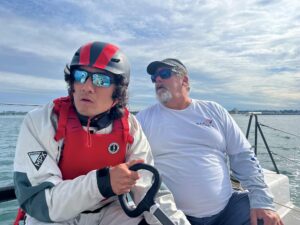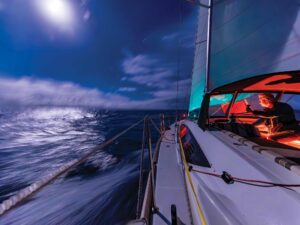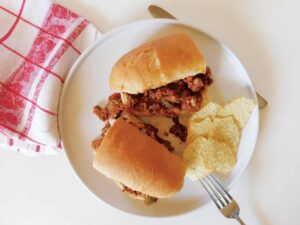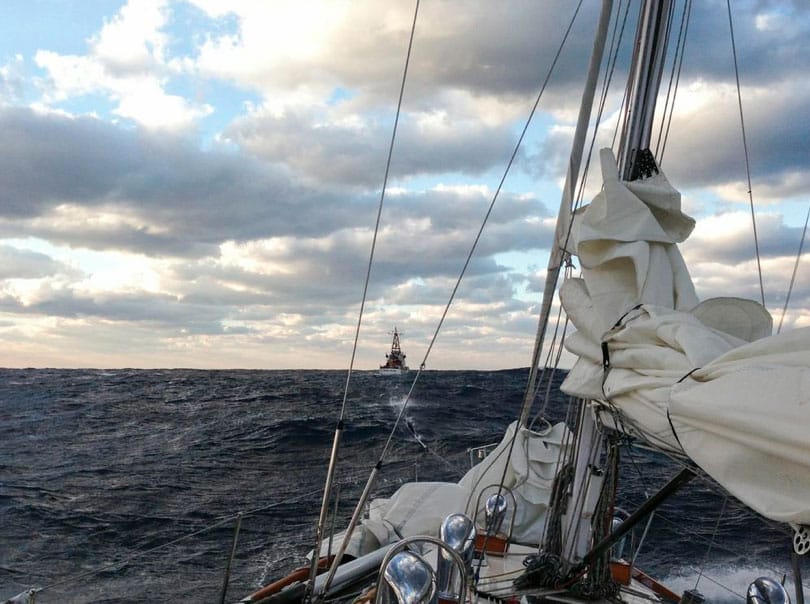
The following is a firsthand account of the experiences aboard the Alden 54 yawl Zulu in the 2013 Salty Dawg Rally. Zulu was one of several boats that needed Coast Guard assistance after experiencing stormy conditions in the Gulf Stream.
On the morning of Wednesday November 6, 2013, we departed Hampton, Virginia, after the diesel mechanic, who was trying to repair our generator, threw up his hands one final time. We — myself and the other crewmembers, Scott and Nate — stopped for last-minute fuel and caffeine provisions before getting underway aboard Zulu, an Alden 54 yawl, down the Chesapeake about noon. We had an easy motor down and out of the Chesapeake with some other boats making the trip to the Caribbean as part of the Salty Dawg Rally, directly into 20-25 knot winds, that were supposed to switch around to the west then north and intensify in the next 48 hours after we had pushed our way through the area. We navigated down the coast toward a waypoint that marked our planned entry point into a narrow part of the Gulf Stream, about 50 miles off of Cape Hatteras.
By the time my watch was over, I was ready to get below and enjoy my six hours of sleep before my next night watch. The weather on deck was cold and rough. The ocean west of the Gulf Stream was North Atlantic water and was 50 to 60 F and the wind was building from the southeast. The boat was handling the conditions nicely but it was difficult to get any real sleep. When I came up for my next watch at 0300, we had turned due east to cross directly through the Gulf Stream and the wind and wave state had continued to build.
There was a spectacular sunrise Thursday morning and although the conditions had continued to build the boat was handling well, and we were making good time. We spent the day sailing with a reefed jib and jigger across the Gulf Stream in 4-6 foot waves and 30 knots sustained with squalls and gusts to 40 knots. We spent the day doing housekeeping and resting below between making sail adjustments and reefing down during the frequent squalls.
At about 1500 Atlantic Time, Scott was preparing to come on watch and I was moving from the comfortable bunk in the main saloon back to my bunk aft of the navigation station to make room for Nate. Just as I lay down I heard what sounded like the autopilot creaking followed by a loud clunk and the call from Nate, “Everyone on deck!” Scott and I grabbed our harnesses and rushed on deck just in time to see our rudder 25 feet behind the boat, drifting away from us.
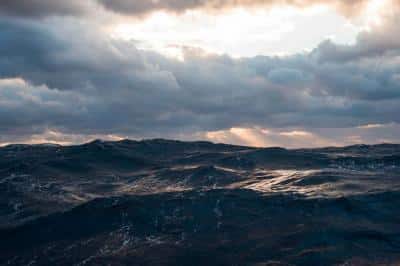
The boat rounded up into the wind and we quickly realized that the helm was completely useless before we started pulling apart the lazarette checking to see if we were taking on water. Surprisingly we were not, so we shifted our focus to trying to steer the boat with the staysail and our reefed mizzen. These attempts lasted with various levels of success and failure for the next hour as we debated rigging the spinnaker pole as a rudder or bolting a makeshift rudder to the transom. We ultimately improvised a sea anchor drogue from a five-gallon bucket and spinnaker sheet off the stern and found a way to back the sails so we were almost hove-to pointing about 45 degrees off the wind, moving to leeward with wind and north with the current at about 1-2 knots.
As it started getting dark, we used the satellite phone to contact my father and then the Coast Guard to inform them of our situation and let them know we were in a safe and stable position, but completely disabled in worsening conditions. While Scott used the sat phone and Nate kept an eye on the boat, I gathered supplies for a ditch bag in the event we had to abandon ship. While moving around the cabin I was thrown off balance, due to the sea state, into an armchair in the saloon breaking it off at its base bolted to the cabin floor. After some time we were able to get word from the owner, that because of our position in the Gulf Stream and the fact the wind was forecast to clock around to the north and intensify, the USCG Cutter Block Island was on its way to assist us.
As we waited the six hours until the cutter’s anticipated arrival on scene we each prepared a personal ditch bag. If we had to abandon we would not be allowed to bring any personal belongings with us, only what was in ziplock bags in the pockets of your foul weather gear. Passport, memory cards, a favorite Swiss army knife, and a baseball cap from Hobie Cat were all double bagged and ready to go in my pockets. We were not sure if when the cutter arrived we would remain aboard Zulu or be taken aboard the cutter, but we wanted to be prepared.
When the cutter arrived around 2300, we were filled with a sense of relief at seeing the running lights of the 110-foot Block Island and talking with their captain. We all decided that the building 10-15 foot seas and 30-40 knot winds made it unsafe for us to attempt to receive a tow line at night. After being disabled and adrift for 8 hours, we all agreed the best thing to do was hunker down for the night and wait until morning for any action. Over the course of the night we were constantly broadsided by waves in the confused building seas of the Gulf Stream causing us to tack over or spin around uncontrollably. The conditions below were so rough that books, water bottles, foul weather gear, Nate’s laptop, anything not bolted down was flying around the cabin or sliding back and forth on the floor. Despite lots of rearranging duffle bags and pillows to try and hold oneself in place in your bunk, we spent an uncomfortable night with very little sleep.
At about 0100, we answered the sat phone to give the USCG an update. Scott talked on the phone for a few minutes stating that it was very rough but we were OK. After finishing the call, Scott complained of intense pain in his side, blaming a fall the other day in waves while also complaining of extreme exhaustion, nausea, and fever. Nate and I assessed his vitals while helping him drink Pedialyte and water as a USCG doctor ashore asked us questions about his condition. After some time he was feeling much better, 2-3 on the pain scale compared with 8-9 earlier. Scott was starting to rest much more comfortably when we heard the staysail tear and start flapping in the 30-40 knot winds. Nate and I donned our wet gear and harnesses and went on deck and forward to the mast to lower and tie down the headsail. Scott was able to muster the energy to get dressed and come up into the cockpit so he could monitor us while we were up forward. Once finished we returned below and decided to keep trying to rest while Nate and I alternated 2 hour watch shifts monitoring the boat and checking on Scott.
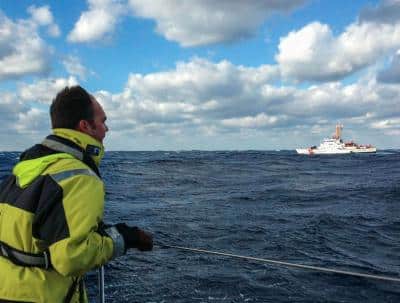
The next morning, the boat was doing well handling the pounding we were taking from the waves in the now very turbulent Gulf Stream. By sunrise the wind had swung around to the north and was still blowing sustained 30-35 knots, this opposing wind against the Gulf Stream had blown the waves into messy 8-12 feet plus swell (or on my surfer scale, 16-25 feet). Our five-gallon bucket drogue had broken free and without our staysail we were drifting abreast to the swell, rising and falling violently off the large waves. By 0800 we were briefed by the Block Island on their plan for giving us a towline and were making preparations to be towed.
Nate and I donned our foul weather gear and harnesses and made our way up onto the bow of the boat. The cutter approached us slowly from upwind and when they were about 50 feet upwind of us they motioned for Nate and I to get down as they used a rope gun to shoot a thin line into our rigging between the two masts. Nate and I would haul in this thin line, which was attached to a much heavier towline. After some help from Scott and a boat hook, Nate and I had the thin line and started hauling in the 100+ feet between us and the cutter. After a few minutes of hauling away on the very thin line the call came over the radio to cut the line. Before Nate and I could react the line went taught and whizzed over the side, slicing both of our hands. The wounds were deep cuts but did not bleed because the line cauterized the wound as it burned through our fingers. We were both very grateful we had taken precaution not to allow the line to wrap around our hands or feet. The cutter came closer, about 15 feet off our bow, and a member of the crew heaved us a throwing line. Nate and I caught the line and immediately hauled away, quickly reaching the much larger dynasteel pennant of the towline. As soon as the line was fed through the fairleads and onto the cleats the crew of the cutter yelled for us to clear the bow. The cutter then paid out 400 feet of towline while getting in position to tow us southwest to Beaufort, North Carolina.
As soon as we got under tow around 0900 we realized that, as expected, the conditions aboard Zulu were going to be very rough while we were towed back through the Gulf Stream. The Captain of the cutter decided the conditions were too rough to run with the wind and waves and we were now going to steam north into the wind and waves back to Norfolk instead. We were only able to make about 3 knots SOG and with about 400 feet of towline between us and the cutter, three to four waves would stack up between us and the cutter and our bow would be pulled over, across, or through the massive waves. Zulu is a very solid sailboat at 54 feet in length, drawing 9ft, and displacing nearly 40,000 pounds, but that did not stop the boat from violently crashing into waves, punching into crests sending a wall of water over the deck, and being hit by breaking whitewater spinning the boat like a top, all before the towline went taught and we were pulled into the face of another wave. Initially Nate and I had been taking turns in the cockpit keeping watching and getting soaked by waves coming over the bow and over the side into the cockpit. I was so impressed with the pounding we were taking I thought it was only a matter of time before the towline snapped or the mast broke.
We spent all of Friday either “resting” below in our bunks or braced in the companionway observing our progress. Sometime in the afternoon a large wave crashed over the entire deck, burst its way through the dodger and into the cockpit drenching Nate who was sitting just inside the dodger, and spilling down below. Our navigation table took a direct hit and our satellite phone, notebooks, and navigation equipment were soaked. Our sat phone, we soon realized, was now destroyed preventing us from communicating with anyone except the crew of the Block Island via VHF radio.
We spent the day continuing to attempt to rest or eat. Scott was feeling better but was still very weak and was having trouble holding water. As we were towed through the middle of the Gulf Stream the conditions were so rough that there was really nothing we could do but wedge ourselves into our bunks and try to rest.
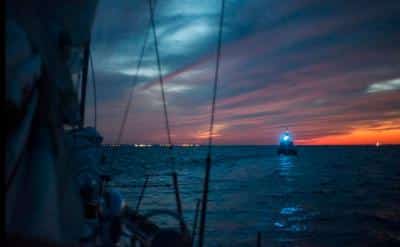
Rest was almost impossible as the boat creaked, groaned, and crashed over and through the waves. I couldn’t stop thinking about the mast and wondering when it would give way or when the towline was going to break. Nate toughed it out and endured the ridiculous seasickness-inducing conditions, while I took seasickness medication to cope with the rough conditions. By sunset we had passed through the middle of the Gulf Stream and knew the conditions were going to slowly start improving. For a while Nate and I took turns keeping watch so Scott could get some rest but eventually all three of us ended up wedged in our bunks with an ever watchful anxiety, riding out the conditions.
I awoke a little after sunrise Saturday morning feeling as though I may have actually gotten an hour or two of real sleep. It was immediately obvious to us that the sea state had subsided considerably and the wind had dropped to a light 15 knots, however now that we were in calmer conditions our lack of rudder was causing us to yaw 45-90 degrees to one side before the towline went taught causing us to swing 45-90 degrees the other direction. This created sickening conditions on board that led to Nate and I spending the morning reconstructing our drogue to try to control the pendulum-like swing of the boat with the sails. With only marginal success we conceded to ride it out. At least the sun was out the waves were smaller.
We spent the day alternating between lying in our bunks, on deck brainstorming new ways to stop our yawing and thinking about what we would do once ashore. It was impossible to read, eat, pee while standing up, or do much of anything besides lay down and ride it out. Our bodies slowly acclimated to the violent motion of the boat and by late afternoon we were in good spirits but very restless. When we were about 10 miles outside the entrance to the Chesapeake a 45-foot USCG RIB came out to tow us the rest of the way to the pier. When instructed, we detached the towline and watched the Block Island steam towards port while we got under tow with the smaller Coast Guard boat. Nate and I were hoping the Block Island would have come within shouting distance so we could have expressed some small measure of thanks, but sadly they were low on fuel and as soon as the other USCG cutter was on scene they continued into port.
We were all incredibly grateful for everything the crew of the Cutter Block Island did for us over the course of those few days. They spent a rough few days standing by us and towing us at a snail’s pace through very rough seas. They were sympathetic to our situation and continually tried to make our ride more tolerable and checked with us about Scott’s condition.
When we finally made it into Little Creek in Norfolk it was nearly 2100. As we slowed down to enter the channel the conditions were very calm and as we drifted to a stop the lack of motion made all of us instantly seasick. I took more seasickness pills in anticipation of land-sickness as our inner ears did somersaults trying to adjust to the lack of motion. The Coast Guard maneuvered us onto a dock where we were met by the boat owner and more Coasties from the base next door who had heard our story and come down to lend a hand docking. After some paperwork we went ashore, attempted with various degrees of success to eat a warm meal, took showers and crashed in stationary hotel beds.
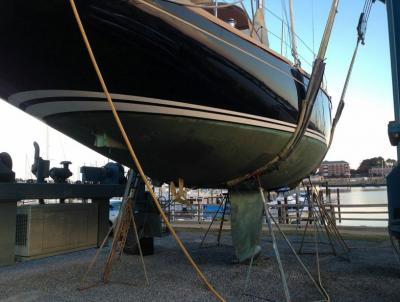
The next morning we awoke at the hotel across the street from where the boat was docked. Scott was still feeling out of it and wanted to head home, he and I were both flying to Providence. I jumped on the same flight with him and went home to my father’s house, while Nate stuck around to help the owner make heads or tails of everything. The next day Scott’s wife emailed to let us know that Scott had seen a doctor who discovered his appendix had burst on Thursday night. He immediately underwent surgery to remove his appendix and is reportedly doing OK but still recovering in the hospital.
Nate is back home in Newport, Rhode Island, with his wife and dog. After being away for a month on another boat, he looking for the next boat get on to.
I have returned to my home on Nantucket and made good on a promise I made to myself while being towed in, that when I got home I would go surfing and sailing immediately. The second day I was on island, my friends and I went surfing in the snow. The waves were all right, but getting into the ocean helped wash the tension and stress of the ordeal away, the fact it was snowing just made it more fun.
The whole crew of Zulu was amazed by a few things: that we lost the rudder and didn’t take on water, that the USCG towed Zulu instead of making us abandon ship, and that no more serious structural damage occurred during the tow. I’m relieved the Block Island was able to tow us back to shore as quickly as they did so that Scott’s condition didn’t worsen while we were offshore.


